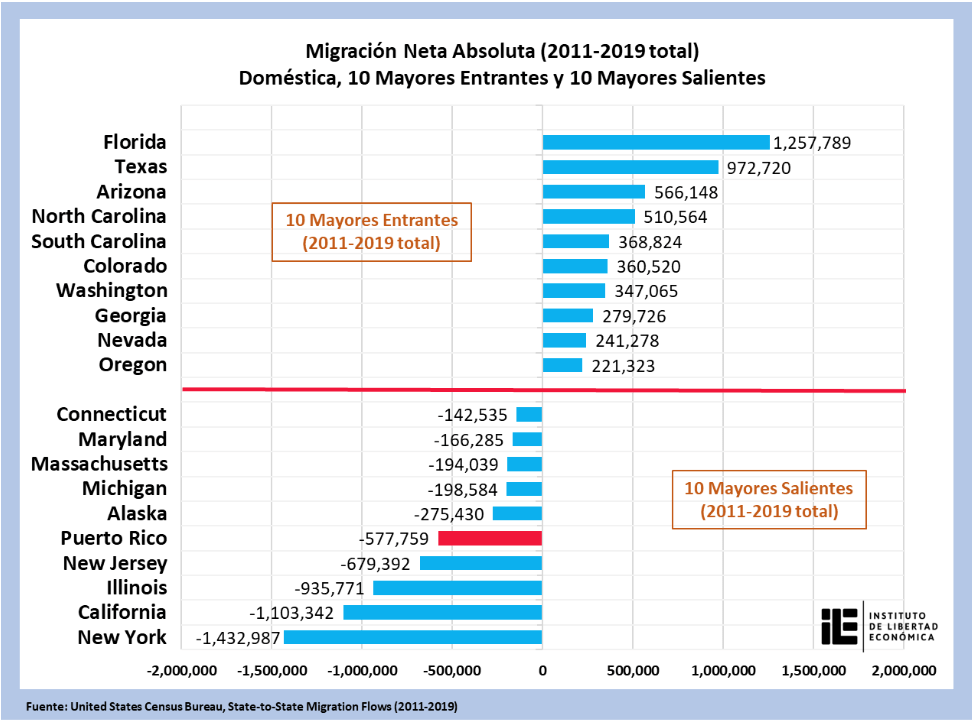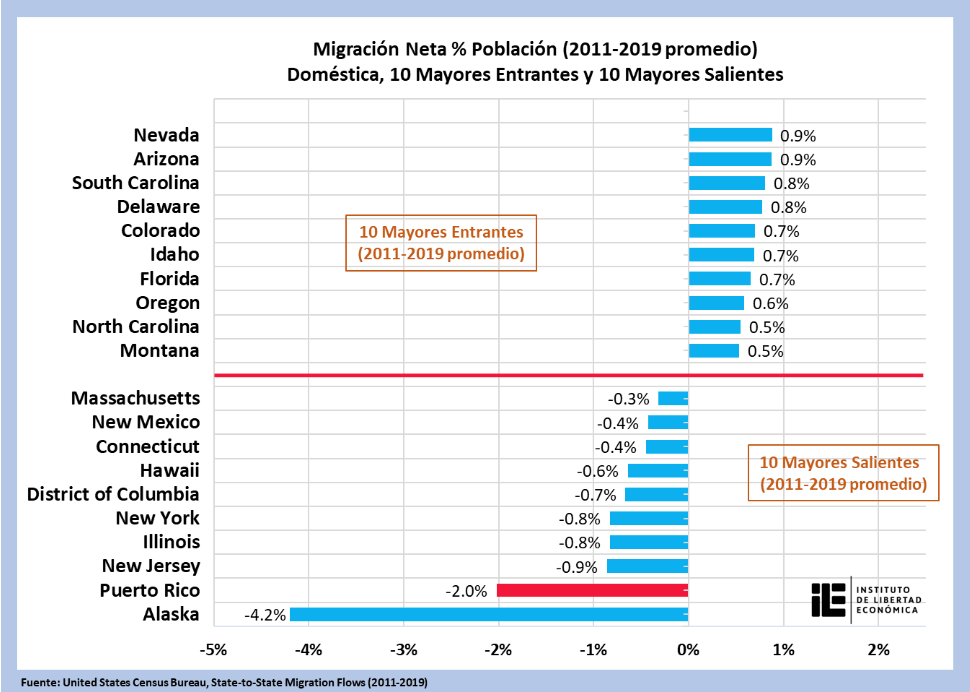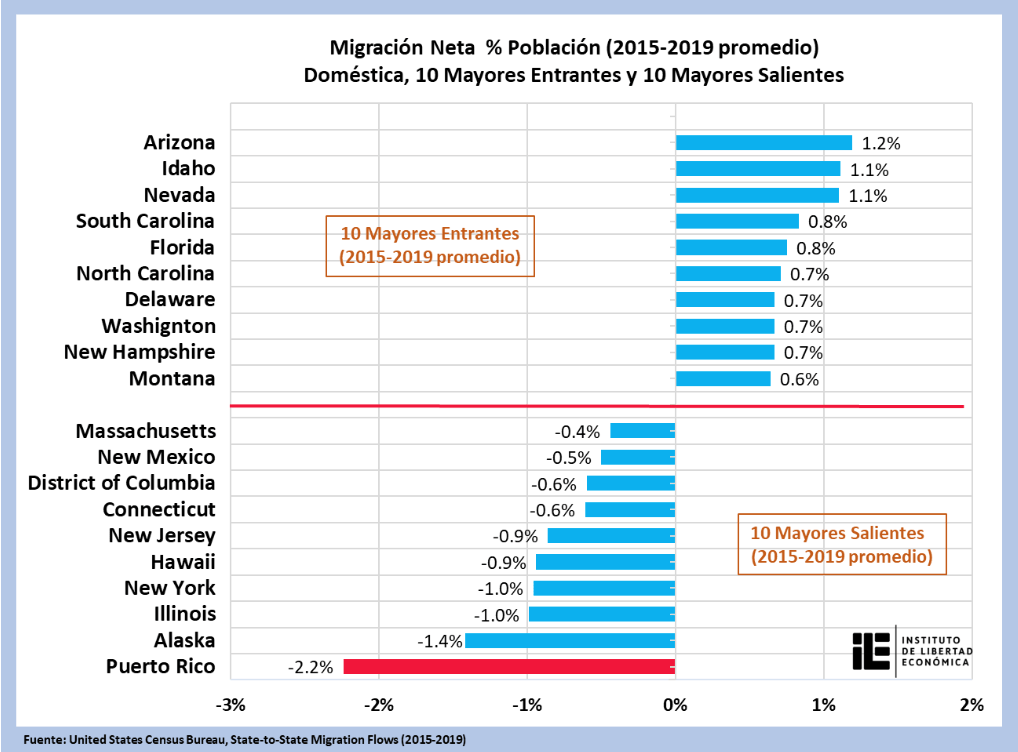Migration is used as a factor to assess the economic freedom of regions, states, and localities. When we investigated the inbound and outbound domestic migration trends of the US, from 2011 to 2019, we found that states and territories where economic freedoms were promoted had higher inbound migrations. On the contrary, where there were fewer economic freedoms, outgoing domestic migrations predominated. When we speak of economic freedoms, we refer to the “right of people to earn an honest living, free from burdensome and unnecessary government intrusions”. 1
The annual study Economic Freedom North America (EFNA) from Fraser Institute, attempts to measure the degree of restrictions on economic freedom imposed by governments in North America. Some of the components used to measure economic freedom in the said study are government spending (general consumption, transfers and subsidies, insurance payments and withdrawals, etc.), contributions (income and payroll taxes, property, sales tax, etc.), regulations (minimum wage legislation, government employment as a percentage of total state employment, union density, etc.), the legal system, and property rights (protection of property rights, judicial independence, impartial courts, etc.), among others. 2
At the same time, the American Legislative Exchange Council (ALEC), in its ranking of economic performance of the states included in the annual report Rich States, Poor States (RSPS), it also evaluates the Gross Domestic Product (GDP), the Non-Farm Payroll Employment and the Absolute Internal Migration of the 50 states for the years 2011-2020.
As per the states’ economic freedom index EFNA 2019 and the RSPS economic performance ranking, states with the highest inbound migrations rank higher on the economic freedom and economic performance indices than states with the highest outbound migrations. If we include Puerto Rico in the analysis of the absolute net migration patterns from state to state during the period of 2011-2019 using the statistics of the US Census Bureau, it can be noted how Puerto Rico is the sixth with the highest outbound migration, even though the populations of the first five states are between 2.5 and 12 times greater than that of Puerto Rico.

On the other hand, when we carry out the same migratory analysis considering the population, Puerto Rico turned out to be the second state with the highest outbound migration during the period from 2011 to 2019. Alaska ranked first reflecting an annual outbound migration, from 2011 to 2014, 5 to 10 times higher than the one it had annually from 2015 to 2019.


If we do the same analysis of net domestic migration by population, between 2015 and 2019, Puerto Rico reflects the largest outbound domestic migration by percentage of population in the entire United States. In fact, it is almost double that of the one that precedes it, Alaska.


In this analysis, ALEC researchers ranked Arizona first in economic performance for that 10-year period. When we look at the statistical analyzes of Arizona, we can see sustained GDP growth, specifically, from 2013 to 2019. Also, inbound migration from Arizona for the period 2011-2020 equaled 562,552 residents, the third state with the most inbound migration. In addition, Arizona has a right-to-work law and its corporate and personal income tax rates are among the lowest nationally.
Another example worth presenting is that of Florida. From 2011 to 2019, Florida increased its GDP from 1.5% to almost 6% and its inbound migration, through 2020, was approximately 1,452,028 residents. Florida also has a right-to-work law and its corporate and personal income tax rate is 0%. On the contrary, New York, one of the states with the highest outbound migration between 2011 and 2019, lost 1,432,987 residents; its GDP decreased from 6% in 2012 to -4% in 2020; and it does not have a right-to-work law. Similarly, California, the second state with the highest outbound migration between 2011 and 2019, lost 1,103,342 residents; its GDP decreased from 4% to -2%; and does not have a right-to-work law.
Finally, in our analysis we found that between 2015 and 2019, Puerto Rico was the US territory with the highest percentage of outbound migration (-2.2%); its GDP was -6% in 2020; nor does it have a right-to-work law. In other words, the states with the highest inbound migration were those with the lowest tax burdens, that encourage entrepreneurial activity, are fiscally healthy and economically vibrant, and whose housing and electricity costs are low. In contrast, those states with higher outbound migration showed higher tax burdens and more regulations, fewer job opportunities, and higher housing and electricity costs. Therefore, to promote the prosperity of a society, it is of the utmost importance that a free economy is promoted, where the government is limited and efficient and allows the market to function without overregulation.
1 Carpenter, D. (2021). El derecho de nacimiento de la libertad económica. Instituto de Libertad Económica para Puerto Rico. https://institutodelibertadeconomica.org/wp-content/uploads/2022/01/Article_The-Birthright-of-Economic-Liberty.pdf
2 Stansel, D., Torra, J., & McMahon, F. (2019). Economic freedom of North America 2019. Fraser Institute.

